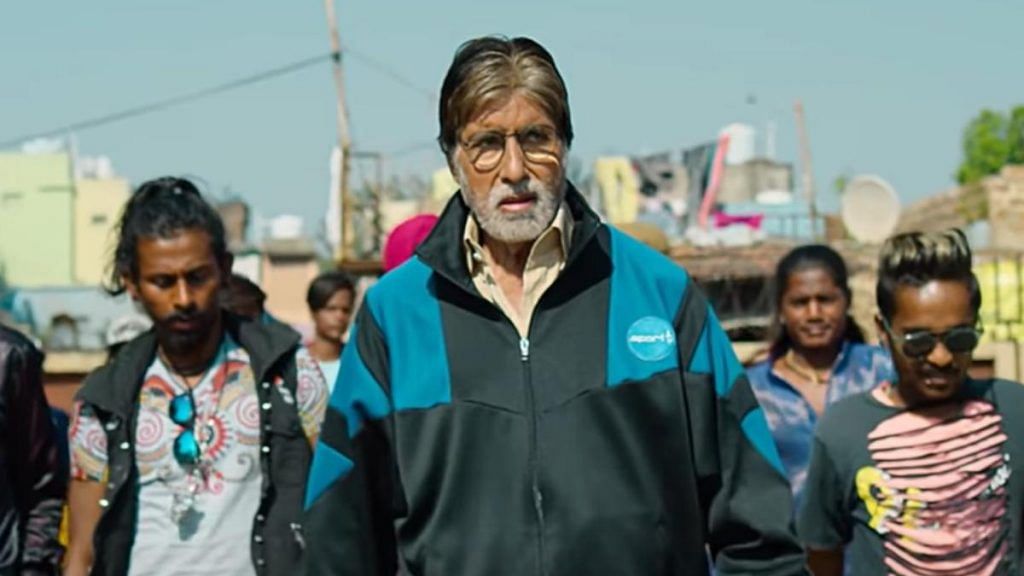The last scene of Nagraj Manjule’s movie Jhund shows an aeroplane flying over a slum in Nagpur, where this reads on the wall — ‘Crossing the wall is strictly prohibited.’
The wall in this scene and much of the movie is symbolic of a lot more — access, upper-caste privilege and perceptions, and what is perceived to be talent. There isn’t a single frame in Jhund that does not have a meaning or purpose.
Steered by Amitabh Bachchan, the film follows a story of a bunch of ‘zopadpati’ children in Nagpur and how a retired sports teacher puts a football in their hands (well, feet) instead of the whitener they sniff, drinks cheap, local alcohol to escape life’s struggles, police brutality and life’s unfair ways, which usually boils down to their caste.
In one of the dialogues, Amitabh Bachchan tells a judge, “No matter how much talent they have, they can’t reach you. There is just too large a wall.”
Each dialogue and backdrop setting serves a larger purpose — questioning the audience’s stereotypes and inner bigotry while delivering a message. At no point does Jhund become preachy, there is just too much humour. At a time of many sports movies, 83 to Jersey, Jhund is a must-watch because Nagraj addresses what others won’t — caste.
Also read: Vikrant Massey, Sanya Malhotra shine in ‘Love Hostel’. But the film doesn’t
Two worlds
One of the most poignant and important stills in the movie is when cinematographer Sudhakar Reddy Yakkanti shows the college football team practising in a carefully manicured field, juxtaposed right near the slum where the zopadpati team is practising amid the waste from the school that is dumped in their backyard.
These two worlds are separated by just one brick wall, which is often tapo-ed, but it is significant of so much more.
Amitabh Bachchan is nearly pitch-perfect in the role of a retired school teacher who takes money from his wife and is determined to build the zopadpati team to make sports a means (zariya, he keeps saying) for a better life. At no point does he embody the larger-than-life persona that he is off-screen, and the credit goes to Manjule’s direction. One could argue that he is not the protagonist but instead, another character ‘Ankush’ (aka Don) is, since he has the character arch and the ‘love interest’ in the movie.
There are parts when Jhund almost takes the turn of a ‘saviour complex’ — it becomes more about Amitabh Bachchan than the team and their struggles. He is said to be the real ‘vijayta’ (winner). Yet, much like Sairat (2016), Manjule lures the audience into a comfortable space to deliver some hard-hitting truths.
Bachchan has a long dialogue where he explains how many of the kids in his team can kill a pig with one stone (referencing Maharashtra’s Scheduled Caste Kaikadi community) to explain their dexterity and says that instead of stones, they need a ball in their hand. He asserts that no one is born a criminal nor decides to be one. And that many of his students are running away from life’s problems. A line from his monologue says, “Beyond universities and schools, there is an India which we need to factor and think about.”
It is from this monologue that one realises why Manjule cast Bachchan — he wanted as many people to hear this and Bachchan was the best way of ensuring that.
Also read: ‘A Thursday’ shows Yami Gautam go from Ms Perfect to Cruella of Colaba. But at what cost?
‘Backdrops’ show real struggle
Nagraj Manjule’s friend, Pa Ranjith, who had been waiting for Jhund, said in earlier interviews that backdrops have tremendous power, as they capture social realities without dialogues or music. Manjule uses this best to convey each aspect of his story — from images of Babasaheb Ambedkar in shops to people of the zopadpati celebrating Ambedkar Jayanti in blue suits. The opening shot of little children segregating waste, cutting animal hides, stealing coal from a moving train, and the security guard dumping the waste from the college into the slum – Manjule says a lot by saying nothing at all.
There is a scene where a girl selected for the national slum football team is trying desperately to get her passport made and needs a ‘pehchan patra’, going from pillar to post. Right in the back is a sign of Digital India — the Narendra Modi government’s campaign to deliver digital access to ‘all Indians’.
Movies from the ‘60s and the ‘80s failed to even have a portrait of Ambedkar. Gandhi (1982) almost entirely left out any reference of Ambedkar in the movie and cut to now, there is a scene where Bachchan looks up to a life-size portrait of Ambedkar, folds his hands, bows down, and walks away. It is an incredible shot to put in a mainstream Bollywood movie and have Amitabh Bachchan show the significance of it.
Much like the backdrop, even the lyrics, fashion, and characters in the movie are unapologetic and seek to take back the narrative and instead turn the lens on the audience.
The title song, ‘Aaya Ye Jhund Hai’, extremely catchy and about to be everyone’s next workout song, does this best. “Apun ki basti gutter mein hai, par tumhare dil mein gand hai”, say the lyrics.
A solid 4.5 out of 5, everyone should watch Jhund and question inner prejudices, what is talent, ‘merit’ and access. It evokes laughter and makes you cry as well. “Gutter ki naali se public ki gaali se, raste pe aaya yeh Jhund hai” – watch out for them.
(Edited by Humra Laeeq)
